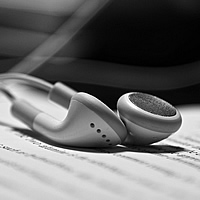One of the benefits of buying a movie in DVD or Blueray is the commentary track that often accompanies the purchased version (often not on the Netflix rental version, darn it). So, once you’ve watched a movie once or several times, you can watch it again while listening to the director or actors or creative team chatter about what you’re watching.
It’s a color commentary, essentially, that doesn’t describe the action, but rather riffs on the making of that moment, the quirks or comedies of the process, or whatever else is evoked in the conversation as the team reunites in a sound studio to watch what they made together.
But Rian Johnson, writer and director of the new big-box movie Looper (starring Bruce Willis and Joseph Gordon-Levitt, now playing at a theater near you…commission please) doesn’t want you to have to wait until the DVD. He’s posted an audio commentary track that you can take into the movie theater with you and listen while you watch.
Johnson is rather adamant that you should actually see the film once before adding the commentary track to your experience. And he’s clear that this is not the same kind of commentary you’ll find on the DVD (it’s more technical and film-maker-ish, for film wonks). Plus, he’s kind enough in the audio intro to make sure you’re not disturbing your neighbors in the theater with a glowing screen or an annoying audio whisper.
Of course, this evolution of the movie theater experience made me wonder about similar opportunities in the live arts. There are official and unofficial audio commentaries for museums now. There is audio description for the live theater for the visually impaired. There have been synchronized Twitter concert notes for live musical performance. There was an experimental in-venue mobile information system for symphony concerts a few years back (remember the Concert Companion?).
And yes, one difference between a movie and a live performance is that a movie has rigidly predictable timing, whereas a live performance can ebb and flow and drift out of sync with a pre-recorded audio track. But the pause button on my iPhone could probably resolve that.
But really, why not? Would you attend the same event more frequently if you had alternate ways to engage it? Would you be interested in what the directors or actors or creative team were thinking about what’s in front of you? Or would it drive you insane (as an actor, director, or audience member) to know that some people in the theater were one step removed from direct experience and distracted from full attention (in which case, I have some bad news for you…many of them already are)?
My response to this in-theater audio commentary is to listen to it without seeing the movie, or to listen while I’m watching a different movie. That feels like a perfectly post-modern, process-over-product thing to do. Plus, it’s free! But anyone else? Is this already happening?



Presumably you wouldn’t need to pause the commentary while listening to a concert. A system like Shazam could presumably detect the beginning of pieces, as long as they were of the kind heard at those are classical-music concerts, or pop concerts where bands play the same way every bloomin’ time out. Perhaps the Shazam-like detector could handle the heads of jazz standards, but it might struggle to figure out which prerecorded comment to provide at concerts of, say, music in any of the improvised styles that abound the world over.
With respect to your excellent suggestion about listening to commentary for film A at film B, I’ve often thought a compelling approach to musical performance would go like this: Performers would listen to, say, a well-known classical composition on headphones (only they would hear that music), and they would play a musical commentary on, or response to, that music, for an audience to hear. (I claim copyright on this idea – it’s gonna be HUGE!)